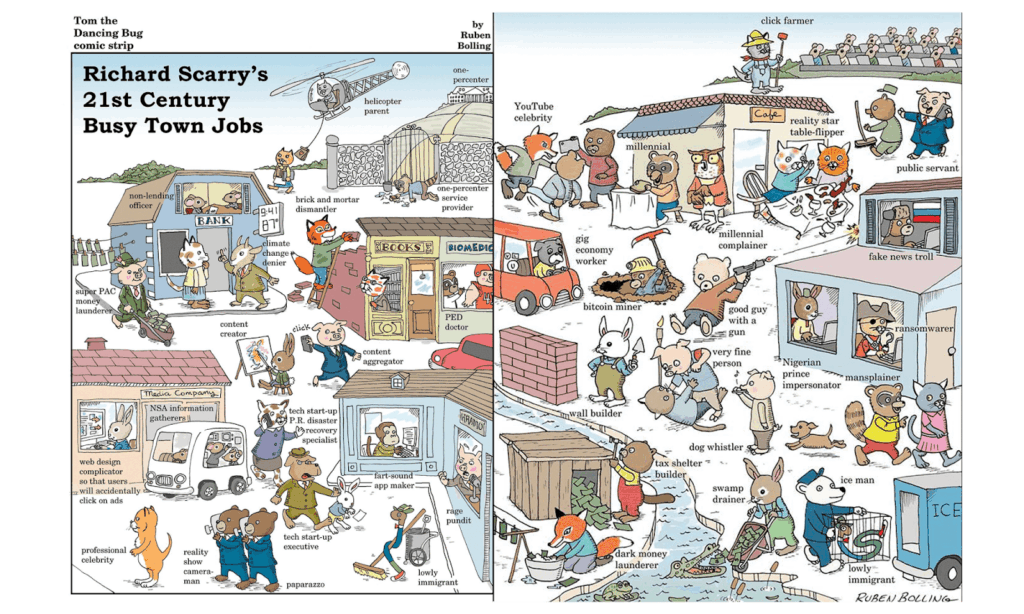Richard Scarry’s Busy Town Jobs for the 21st Century
The world of Richard Scarry’s Busytown shows a wide variety of jobs—bakers, postmen, fire-fighters and repairmen — and those roles reflect a mid-20th-century vision of work. In the 21st century, many of these jobs are changing dramatically. Advances in technology, global supply chains and remote working have altered what “work” looks like. This text explores how several classic Busytown jobs might adapt for modern times and what that means for work, community and purpose.

From Traditional to Updated Roles
In Busytown, characters often work within their town’s local economy: someone runs the bakery, another repairs machinery, another delivers letters. Today those roles still exist but they often require new skills, digital tools and global coordination.
Take the baker: originally this meant kneading dough, operating an oven and selling in-store. Today a baker might oversee automated ovens, manage online orders and coordinate delivery logistics across a city or region. The core function — making baked goods — remains, but the scope and skill-set expand.
The repairman in Busytown fixed broken tools or cars. In the 21st century that role might shift into servicing electronic devices, diagnosing software issues or working with smart-equipment. The nature of asked-for repairs has shifted from mechanical to digital or hybrid systems.
The postman in Busytown walked familiar routes delivering letters. Now the delivery role might include managing drones or autonomous vehicles, tracking parcels via an app and handling logistics in a networked supply-chain. Even in local delivery, coordination with warehouses and real-time data is involved.
Examples of 21st-Century Adaptations
Modern versions of Busytown jobs blend familiar tasks with contemporary tools.
- Automated Machine Technician – The repairman becomes a technician for complex equipment: smart machinery, IoT devices and predictive maintenance systems. The job retains fixing and helping, but with code, sensors and diagnostics.
- Urban Mobility Manager – In Busytown someone might operate vehicles or assist in traffic. Today that role becomes overseeing shared-mobility fleets, electric bikes, data on transport usage, and coordinating with city tech systems.
- Community Health Worker-Technologist – While Busytown shows doctors and nurses, modern equivalents work with telehealth, mobile apps, remote monitoring systems, and coordinate care across networks. The job remains helping people, but the tools expand.
What Has Changed and What Hasn’t
Some core features of work remain: someone still makes goods, someone still delivers goods, someone still fixes things, someone still helps others. What has changed is scale, connectivity, expectations. In the 21st century these jobs may require:
- Digital literacy
- Global supply-chain awareness
- Remote coordination
- Data analysis
- Sustainability considerations
However, the fundamental idea remains: each person contributes to the functioning of a community. Busytown presents this idea simply; the modern model adds complexity.
Impact on Community and Skillsets
As jobs evolve, the communities around them change too. In Busytown everyone works locally; they know each other and depend on each other. In a modern town or city, roles may span continents, but the local dependency remains: someone still must bake bread, someone still must deliver packages, someone still must fix things. The difference lies in how they do it.
Skillsets in these jobs now blend old and new. A baker needs sanitation knowledge and ovens (traditional) plus an ecommerce site and data on orders (modern). A repairman needs mechanical understanding plus ability to work with sensor data and software. A delivery driver may need to coordinate with digital logistics platforms.
This shift also affects training and education. Where Busytown might show apprenticeship in-town, modern equivalents may require certificates in digital systems, continuous learning as technology changes and flexibility in job roles as tasks shift.

Challenges and Opportunities
Modernising Busytown jobs raises questions. Automation threatens some routine tasks; if machines can deliver parcels or drive vehicles, what happens to the traditional courier role? The answer may lie in roles shifting to oversight, management, maintenance and customer-service aspects instead of purely physical delivery.
Another challenge is inequality: access to technology, training and networks determines who can move into these updated roles. Busytown assumed everyone had access to work; modern reality is more uneven. Towns and cities must invest in infrastructure, education and support if local jobs are to transform rather than vanish.
On the opportunity side, new roles invite creativity, sustainability, localisation. A modern Baker might focus on artisanal production, zero-waste delivery and community engagement. A machine technician might focus on renewable-energy systems, smart homes and local generation rather than only fixing cars. Jobs evolve, but purpose remains strong.
What This Means for Busytown Today
If Busytown were updated today, Huckle Cat might train in a tech-repair academy. Mr. Fix-It might operate drones to inspect buildings. The Postman might manage a fleet of cargo bicycles and autonomous lockers. The bakery might run a subscription model and track carbon footprint. The fire-station might use real-time sensors and predictive alerts. The town’s map remains, but each building houses new workflow.
These changes also invite children to think differently about work: not just what you do today, but how you might adapt, learn and shift roles over time. The lesson of Busytown remains relevant: work matters, contributing to community matters, and change is constant.
